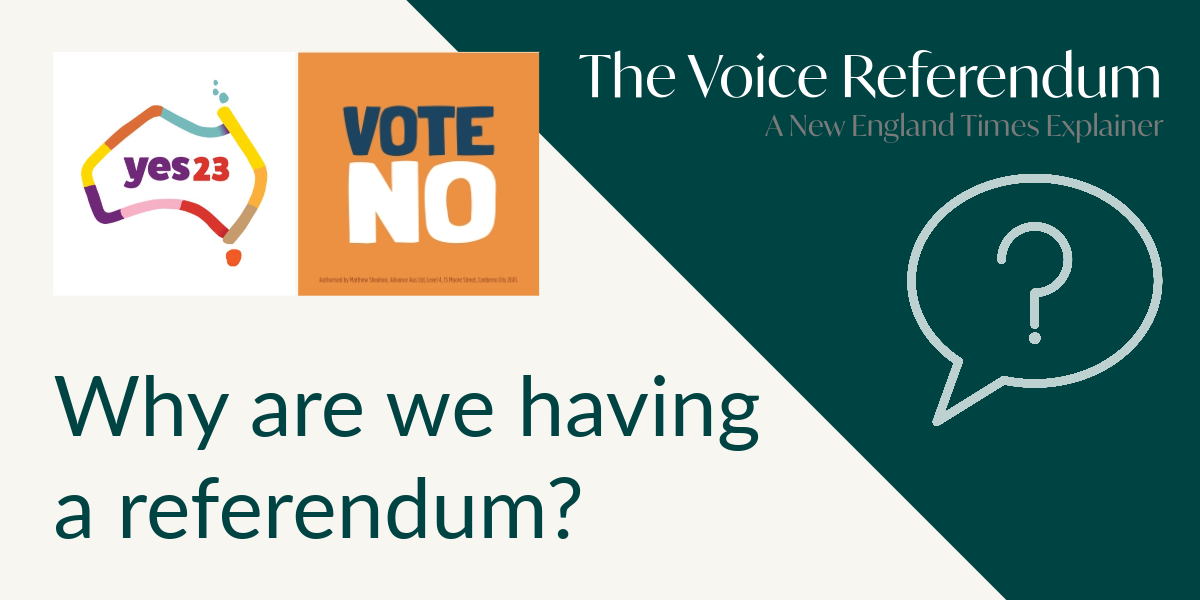This is the first in a series of explainer articles about The Voice referendum, based off the things you’re telling us you want to know in our survey. You can still take part in the survey until September 30 here.
Australia will go to the polls on October 14 to vote Yes or No to a proposal to change the Constitution. This is a special kind of vote called a referendum.
Why are we having this referendum?
Any change to the Constitution can only be made with a referendum.
The Constitution is the framework for all other legislation, so it should be hard to change, and it is deliberately worded in such a way as to allow some wiggle room for changing attitudes and standards over time.
The Government is asking for this change to the Constitution to do two things:
- Formally recognise Aboriginal and Torres Strait Islanders as the first peoples of Australia, and
- Require that there must be an organisation to advise the Parliament on issues that affect Aboriginal and Torres Strait Islander peoples
There is little debate about the first part of that – most people recognise Aboriginal and Torres Strait Islander peoples as the first peoples of this country, this change is just putting that in the Constitution. John Howard proposed doing this in the republic referendum in 1999 too, and all sides of the political debate generally agree there should be recognition of Indigenous Australians in the Constitution.
The disagreement is over the second part – the Indigenous Voice to Parliament, which is most often just called ‘The Voice’. Having a ‘voice’ to parliament is one of the things requested in 2017 in the ‘Uluru Statement from the Heart‘. The idea is that this ‘voice’ will be an advisory body that will enable Indigenous Australians to have a clear voice in to the political process on a regular and ongoing basis.
A really important thing to understand is that this referendum will not set up the ‘voice’ body, specify what it does or who is on it, or any of that detail. All of that needs to be worked out by Parliament if the referendum is successful.
Remember, the Constitution is a bit vague by design so our laws can be flexible with the times: so this change to the Constitution you will vote on in the referendum will only recognise Aboriginal and Torres Strait Islander peoples as the first peoples of this country, and require that some kind of an organisation to give Parliament advice on issues that affect them exists. Nothing else.
Why does this need to be in the constitution?
There is little disagreement that we should recognise the first peoples of this country in the Constitution in some way.
Advocates want to add the requirement that there must be an Indigenous Voice to Parliament to the Constitution so that it becomes part of the framework of our laws, and just part of how our country is governed, that the government consults Indigenous people and ask them what they think when making laws about them.
The strongest argument for having it in the constitution that there must be a body is the long history of national advisory bodies that get dumped when there’s a change in government.
We can’t say it better than this video that is getting widely shared on the socials – basically, there’s been a number of different attempts at getting a national Indigenous representative body or process in place, and (white) politicians keep getting rid of it. This change would mean they can’t do that – they can change the body, how it works or who is on it, but they can’t just get rid of it.
The other really important reason to have this in the Constitution is that the federal government does, from time to time, make laws specifically about Aboriginal and Torres Strait Islanders that do not apply to other Australians. The race power in Section 51 of the Constitution allows the parliament to make laws about any race (and there is a separate debate about whether that should be there) but in practice, the only people that get special laws are Aboriginal and Torres Strait Islander peoples. For this reason it is really important that there is a constitutionally protected way for Aboriginal and Torres Strait Islanders to have a say on the laws that only affect them.
There are lots more arguments for and against the measure in the Yes and No cases which we’ll cover in a separate story.
What are we voting on?
This is the exact question that will be on the referendum ballot paper:
A Proposed Law: to alter the Constitution to recognise the First Peoples of Australia by establishing an Aboriginal and Torres Strait Islander Voice. Do you approve this proposed alteration?
You will need to write the word Yes or No on your ballot paper.
If the vote is Yes, then a new chapter will be added to the constitution. This is the exact wording of that new chapter:
129 Aboriginal and Torres Strait Islander Voice
In recognition of Aboriginal and Torres Strait Islander peoples as the First Peoples of Australia:
1. there shall be a body, to be called the Aboriginal and Torres Strait Islander Voice;
2. the Aboriginal and Torres Strait Islander Voice may make representations to the Parliament and the Executive Government of the Commonwealth on matters relating to Aboriginal and Torres Strait Islander peoples;
3. the Parliament shall, subject to this Constitution, have power to make laws with respect to matters relating to the Aboriginal and Torres Strait Islander Voice, including its composition, functions, powers and procedures.
Note again, that the wording to go in to the Constitution is deliberately brief and allows for wiggle room as values and practices change over time. This says Parliament has the power to determine the structure of the Voice body, who is on it and what it does. The referendum and the constitutional change is only to recognise the first peoples of this country, and require that there is a body to advise the Parliament on matters that affect Aboriginal and Torres Strait Islander peoples.
How many people need to vote Yes for this to pass?
For a referendum to pass, there needs to be a double majority: so 50% + 1 voters need to vote Yes Australia wide, AND 50% + 1 voters in at least 4 of the 6 states need to vote Yes.
There are 17,676,347 registered voters in Australia according to the AEC. So 8,838,174 voters need to vote Yes to pass the first part of the double majority.
To pass the second part, 50% of voters need to vote Yes in at least 4 states. So if the Yes vote wins in NSW, Victoria and Queensland, but loses Tasmania, SA, and WA, it doesn’t matter that the vote was clearly Yes nationally – the referendum will still fail. The ACT and Northern Territory, being territories and not states, don’t get counted in this second test. This bit may sound unfair, but it is to protect little states like Tasmania being bullied into something they don’t want by bigger states like New South Wales.
Where to learn more about the referendum:
- For the nuts and bolts about how the referendum works, go to the Australian Electoral Commission’s site: https://www.aec.gov.au/referendums/
- The ABC Voice Referendum portal https://www.abc.net.au/news/voice-to-parliament-referendum
- The SBS Voice Referendum portal https://www.sbs.com.au/language/english/en/voice-referendum
- The Australian Government official website https://voice.gov.au/
- The main Yes campaign site https://www.yes23.com.au/
- There is a number of No campaigns, the main conservative No site is ‘Fair Australia’ https://www.fairaustralia.com.au/
- The Blak Sovereign Movement who are opposed to the referendum being held at all has their response to both the Yes and No cases at https://blaksovereignmovement.com/
Like what you’re reading? Support New England Times by making a small contribution today and help us keep delivering local news paywall-free. Donate now


